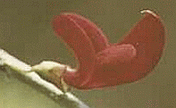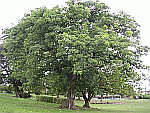

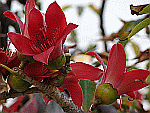
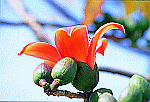
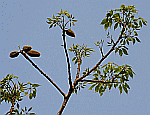
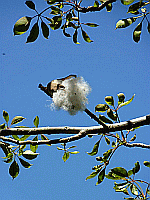
|

english.kmfa.gov.tw
Description: Large, stately, quick- growing, deciduous tree, to 25 m tall (80 ft), and in its natural habitat reportedly reaching a full size of 50 m or more (160 ft); a handsome, striking sight when covered with its bright red flowers; trunk large, straight, and buttressed; in younger trees, stem and branches usually very spinney; wood soft and without heartwood; leaves alternate and palmate, with long petioles, 8-15 cm (3-6 in), and 5-7 leaflets, each 10-20 cm x 3-5.5 cm (4-8 in x 1.2-2.1 in); in Dominica, around the end of February, tree drops leaves then flowers, producing all over tree a profusion of large, bright-red flowers, about 10-12 cm in diameter (4-4.7 in), for 2-3 weeks; flowers at branch ends, often in clusters; petals 8-12 cm x 3-4 cm (3-4.7 in x 1.2-1.6 in); calyx greenish-brown and fleshy; fruit is a dark brown, oblong, woody capsule, 10-15 cm long (4-6 in), with numerous seeds embedded in long, woolly, reddish fibers; when ripe, pods split open releasing the fiber-supported, wind-born seeds; the Bombax tree in the Gardens, located near the cricket pavilion, flowers but does not fruit, apparently needing a more moist climate; fruit photos are illustrative.
Plant Family: Belongs to Bombacaceae family, which includes some very large trees such as the giant Silk Cotton (Ceiba pentandra), and the large-trunked Baobab (Adansonia digitata).
Natural Habitat: Thrives in hot, moist, tropical rainforest, on deep sandy loam, with high rainfall well distributed throughout year, such as in the hotter regions of India, eastern Himalayas and Bengal.
Origin and Distribution: Native to SE Asia; is widely cultivated throughout the tropics and subtropics as specimen ornamental; propagation by seed.
Uses: In large, formal gardens, tree used as specimen ornamental for its vibrant red flowering. In SE Asia, large, soft-wooded trunk used for dugout canoes; wood widely used for making matches; fleshy calyces can be cooked as vegetable; fiber around seeds similar to cotton, called kapok in India, used to fill floatation devices, pillows and mattresses; seed oil used in manufacture of soaps and lubricants; medicinally, roots of young tree reportedly have astringent and aphrodisiac properties; gum from tree used in India for diarrhea and dysentery.
Indigenous Legends and Anecdotes: Reportedly, Bombax means ‘silk or cotton’ in Greek; in Hong Kong, folk wisdom states that soon after the tree blooms, the weather will get hotter, and that seems to be the case in Dominica also (click here).
References:
Rajendra, K.C. “A Brief introduction to Semal (Bombaz ceiba Linn).” Georg-August University, Gottingen, Germany, TIF 2007/2008 (www.forestrynepal.org, Nov.2009)
“Bombax ceiba.” Flora of China. FOC Vol.12, Page 300-01 (www.efloras.org, Nov.2009)
Arlington A. James. An Illustrated Guide to Dominica’s Botanic Gardens. Forestry, Wildlife and Parks Division, Ministry of Agriculture, Dominica 2007
Robert A. DeFilipps. Useful Plants of the Commonwealth of Dominica, West Indies. Smithsonian Institution, Washington, D.C. 1998
H.F. Macmillan. Tropical Planting and Gardening. Macmillan, London 1956
Jack Charest and Penny N. Honychurch. A General Guide to the Botanic Gardens of Dominica. Ministry of Agriculture, Dominica 1977
C.D. Adams. Flowering Plants of Jamaica. University of the West Indies, Mona, Glasgow University Press 1972
Dan H. Nicolson. “Nomenclature of Bombax, Ceiba (Bombacaceae) and Cochlospermum (Cochlospermaceae) and Their Type Species.” Taxon 28(4): 367-373, Aug. 1979 (www.jstor.org, Nov 2009)
|

